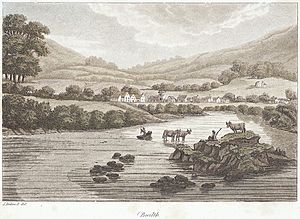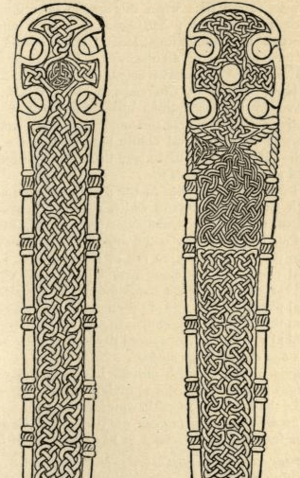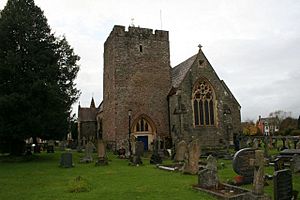Buellt facts for kids
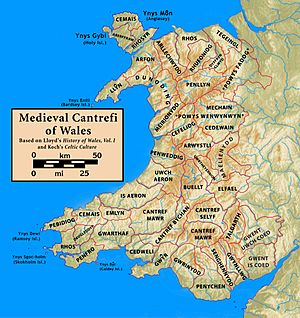
Buellt (also called Builth) was an old area in medieval Wales. It was west of the River Wye. Unlike many other areas, it was often ruled by its own local leaders. It wasn't part of the big Welsh kingdoms for a long time.
Later, during the Norman era, it became linked with Rhwng Gwy a Hafren. This was a region that was free from the Welsh kings. Instead, powerful Norman lords called Marcher Lords controlled it. In the 1500s, Buellt became a "hundred" (a type of local area). It then joined with the old kingdom of Brycheiniog to form Brecknockshire county.
Contents
What Does Buellt Mean?
The name Buellt (or Buallt) comes from old Welsh words. Bu means "ox" and gellt (later gwellt) means "pasture". So, it means "ox pasture". This name later changed to Builth, like the modern town of Builth Wells.
Where Was Buellt Located?
Buellt was in the valley of Afon Irfon. Its borders were roughly the Cambrian Mountains to the north. The River Wye was to the east. The Mynydd Epynt hills were to the south. Ceredigion was to the west.
Buellt was often seen as part of Rhwng Gwy a Hafren. This name means English: Between Wye and Severn. This was true even though Buellt was west of the River Wye. The area was split into four smaller parts called commotes. Their exact borders are not clear today. These were Treflys, Pebuellt, Dinan, and Is Irfon. Most important places in Buellt were along the Irfon river. This included the courts for the commotes. The main church was at Llanafan Fawr. It was named after Saint Afan Buellt, who was the main saint of the area.
Buellt's Early History
We don't know exactly when Buellt became its own political area. It likely grew from older tribal lands. In the Early Middle Ages, Buellt and Gwrtheyrnion (across the Wye) formed a small kingdom. The rulers of this kingdom said they were related to Vortigern. He was a famous warlord from the 400s. Gwrtheyrnion was named after him (Welsh: Gwrtheyrn).
A book from the 800s, Historia Brittonum, tells us about this kingdom. The book says that Vortigern's son, Pascent, ruled Buellt and Gwrtheyrnion. This was after Vortigern had problems with the Anglo-Saxons. The book also links Ffernfael ap Tewdwr, a ruler from the 800s, to Vortigern.
The Historia also mentions a "Carn Cabal" in Buellt. This was a stone with a dog's paw print. It was said to be the print of King Arthur's dog, Cavall. Cavall supposedly left the print while chasing a wild boar called Troyt. Arthur then put this stone on top of a pile of stones (cairn). The story says that if anyone moved the stone, it would be back in its place the next day. The name of this place still exists as Carn Gafallt near Rhayader. But it's probably not the same hill mentioned in the old book.
By the 1000s, Buellt and the rest of Rhwng Gwy a Hafren were ruled by a different family. This family was related to Elystan Glodrydd.
Norman Times and Castles
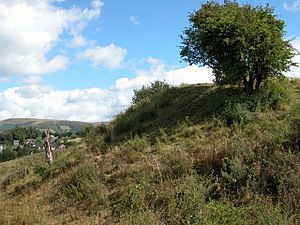
During the High Middle Ages, other kings sometimes took control of Buellt. But it usually became independent again after they died. When the Normans invaded Wales, a powerful lord named Philip de Braose took Buellt in 1095. Philip built a wooden castle on a hill east of today's Builth Wells. This was a motte and bailey castle. He held the area until he died in 1134. Then his son, William, took over.
However, the old Welsh family from Elystan kept fighting the Norman lords. Buellt changed hands many times. Both Norman lords like Roger Mortimer of Wigmore and Welsh leaders like Rhys ap Gruffudd and Llywelyn the Great ruled it.
Buellt later went to Llywelyn the Great's grandson, Llywelyn ap Gruffudd. King Henry III agreed to Llywelyn's right to Buellt in the 1267 Treaty of Montgomery. But in November 1282, Edward I took over Buellt. This was part of his final conquest of Wales.
Edward I ordered a stone Builth Castle to be built. It was on the site of the old wooden fort that had burned down. But they stopped building it because they ran out of money. The castle was used during the rebellions of Madog ap Llywelyn and Owain Glyndŵr. After that, it was left empty. In the 1600s, it was damaged by fire. People then took its stones to use for other buildings. Now, almost nothing is left of the castle.
In the 1500s, King Henry VIII passed the Laws in Wales Acts 1535–1542. As part of these laws, Buellt became a "hundred". It joined with Brycheiniog to form the new county of Brecknockshire. In 1996, the area became part of the modern county of Powys. The old name of Buellt lives on in the town of Builth Wells and the nearby Builth Castle site.


